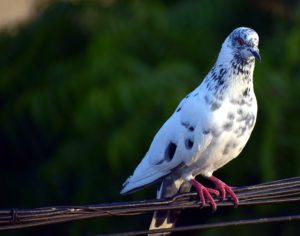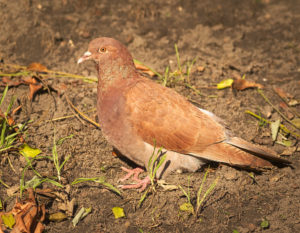 Feral pigeon also known as city doves, city pigeons or street pigeons; they are derived from the domestic pigeons that are derived from the domestic pigeons that returned to the wild. The feral pigeon can be grey, brown, or white, but are usually grey in color with two black bars across each wing and iridescent feathers around the neck and broadband across the end of the tail. One cannot identify the difference between the male and the female. Since domestic pigeons can be easily identified. They have a lifespan of 3 to 4 years in the wild and up to 16 years in captivity.
Feral pigeon also known as city doves, city pigeons or street pigeons; they are derived from the domestic pigeons that are derived from the domestic pigeons that returned to the wild. The feral pigeon can be grey, brown, or white, but are usually grey in color with two black bars across each wing and iridescent feathers around the neck and broadband across the end of the tail. One cannot identify the difference between the male and the female. Since domestic pigeons can be easily identified. They have a lifespan of 3 to 4 years in the wild and up to 16 years in captivity.
Feral pigeon causes a huge nuisance everywhere and they are not afraid of humans. Feral pigeons roost and nest wherever there are food and shelter and take up the residence almost anywhere like the houses, tall buildings, schools, etc. They are known to spoil the areas of mass transit due to the highly corrosive nature of acid released from their excrement. Also, their dropping on industrial, commercial, and domestic buildings causing hygiene concerns and extensively damaging air- conditioning units and other rooftop machinery.
The feral pigeon is more common in the urban environment. Increased urban development has resulted in an increase in the number of feral pigeons due to a large number of accessible nesting spaces and easy availability of food and water. Pigeons are capable of breeding throughout the year and do not migrate far from their birthplace which can be difficult to move them from their location.

Feral pigeons can be dangerous to human health as they transmit diseases through their droppings. We should not touch or pick up pigeon droppings with our hands, it’s very difficult. Pigeon droppings that are infected with bacteria or viruses are often left on the street, windows, and cars, etc and they dry out. Once they do, they become a powder, which is blown into the air and then inhaled. The inhalation of this powder is one way that the pathogens that can cause disease can be spread to humans. Doctors stated that the increase in the number of people with lung disease, or stiffening of the organ, in the city can be linked to the nesting of pigeons.
The most common pathogens which can cause disease transmitted from pigeons to humans are:
- E. coli: This occurs when bird droppings land in water or food supply and are then consumed by humans. This can typically be avoided by washing the food thoroughly before eating. Symptoms include nausea, fever, and cramps.
- St. Louis encephalitis: This disease is spread by mosquitoes after they feed on a bird that carries the pathogen that spreads St. Louis encephalitis. This inflammation of the nervous system is dangerous to all age groups but can be particularly dangerous and even fatal in adults over 60 years old. Symptoms include drowsiness, headache, and fever.
- Histoplasmosis: This respiratory disease occurs as a result of a fungus growing in pigeon droppings and can be fatal.
- Candidiasis: This disease is also a respiratory condition caused by a fungus or yeast found in droppings. The areas affected include skin, mouth, the respiratory system, intestines, and the urogenital tract, particularly in women.
- Salmonellosis: This disease is commonly called “food poisoning” and spreads via infected droppings turning into dust and contaminating food and food preparation surfaces prior to consumption.
The evidence on feral pigeon nuisance,
Feeding feral pigeons in Clark County could result in jail, fines
By Nina Porciuncula from 13 Action News
LAS VEGAS (KTNV) – Pigeons – they’re everywhere you look and for some, they’ve become a neighborhood nuisance.
On Tuesday, Clark County commissioners voted to ban people from feeding them to control their population. If you’re caught, you could pay a fine of up to a thousand dollars and go to jail for up to six months.
Thomas Flores says his neighborhood has become a home to wild pigeons. “I can’t even come out of my house without having pigeons flying by my head, on my roof, on the street, and the sidewalk – on my lawn,” says Flores.
These birds’ poop can damage your roof or your air-conditioning unit. Even worse, pigeons and their droppings carry over 60 diseases.
When it comes to these nuisance birds, Todd Wagner of a better day pigeon control has seen it all.
“From the roof caving in from so many feces. The gas stations also, I’ve seen some of them. So much feces the wind and the rain. If it gets a good rain it will blow right over,” says Wagner.
He recommends taking these measures to help keep pigeons out.
“Don’t feed the animals outside, cats and dogs outside they love that food. If you have a spillover on your pool, get something to cover that up.”
Henderson passed a similar law back in 2011 banning people from feeding pigeons.
Pune: Pigeons Causing Nuisance Leaves Many People With Lung Infections And Asthma
By Chaitraly Deshmukh from Mid-day.com
The significant growth in the population of the pigeons in Pune city has become troublesome to Punekars. Due to the misconceptions and disbelief, the pigeons are fed grains by the masses. Citizens health is the most affected by the increasing number of pigeons in the city. Considering the threat to citizen’s health, the Pune Municipal Corporation’s Environment department have studied a health report and submitted such report to the standing committee.
The wrong yet the habitual practice of feeding the pigeons has cost many health issues to the city’s residents. Most of the of pigeons are seated on the terrace of tall buildings, narrow lanes, and many residential areas. According to a survey many Punekars are suffering from fungal infections due to the pigeon menace. Plus, the number of patients with respiratory disorders and asthma has also been growing because of the feather that they lose. Not only that the foul smell of the waste that the ducks excrete is also bothering the residents.
According to the reports from the Environmental Department pigeons are prominently seen at the premises of Omkareshwar temple, Saras Baug, River road and KEM hospital. The reports also mention that the excreted waste and the feathers are also one of the reasons why citizen are suffering from Hypersensitive Pneumonia.
It is observed that gradually the sizes of the lungs are reducing. Plus, the lung diseases are also increasing. Even the oxygen level is reducing because of which people are facing breathing problems and often many of the patients are kept on a ventilator.
All the living entities are really important for the ecosystem, but if the population of any species is suddenly increased or decreased it creates an imbalance. Therefore, it is really important to take the right kind of efforts to maintain it. India is a country with varied cultures and it is these cultures that make human beings believe in many superstitions and disbelief. This has created a gulf in the lifestyles of Punekars. Their health has been extremely affected by it.
There is a solution with C Tech Corporation to keep the pigeon away from perching and roosting.
CombirepelTM Bird repellent lacquer is the product produced by C Tech Corporation to prevent the menace caused by birds. This product is specially designed to prevent bird perching and roosting.
It is available in the form of concentrate lacquer. The product causes the bird’s pain receptors associated with taste. Some birds use their sense of smell through which they recognize that the product is a threat. The product is specially designed to prevent perching and roosting of birds. Repellent evokes a physiological effect that the birds associated with a sensory cue and then learn to avoid it.
The product is anti-corrosive and has no effect on UV light. The product is transparent and is compatible with most of the surfaces which are easy to apply.
Thus using the bird’s sensory mechanism we can get rid of them without causing them any physical harm.
Contact us at technical.marketing@ctechcorporation.com to keep the pests away.
Also, visit our websites:
1] http://www.ctechcorporation.com/
2] http://www.rodrepel.com/
3] http://www.termirepel.com/
4] http://www.combirepel.com/
Follow our Facebook pages at:
1] https://www.facebook.com/Combirepel-411710912249274/
2] https://www.facebook.com/Termirepel-104225413091251/
3] https://www.facebook.com/Rodrepel-120734974768048/
Follow us on our Twitter pages at:
1] https://twitter.com/rodrepel
2] https://twitter.com/termirepel
3] https://twitter.com/combirepel
